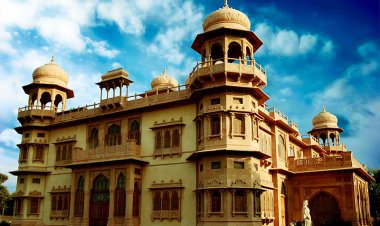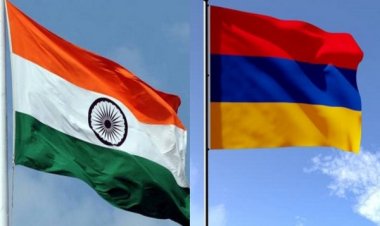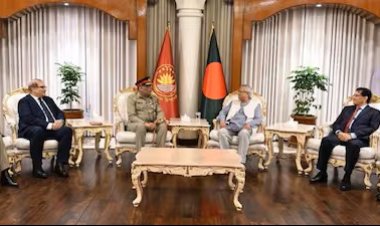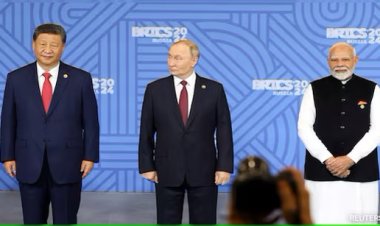India's Railway Diplomacy: Creating a 'New Frontier' in World Railway Network
The following commentary looks at the evolution of the Indian Railways from colonial to the post-colonial era, how it has transformed and evolved. It also looks at how globalisation has played a significant role in the transformation of the railways and looks at the international players involved in the railways, its expansion and potential challenges it may be facing.
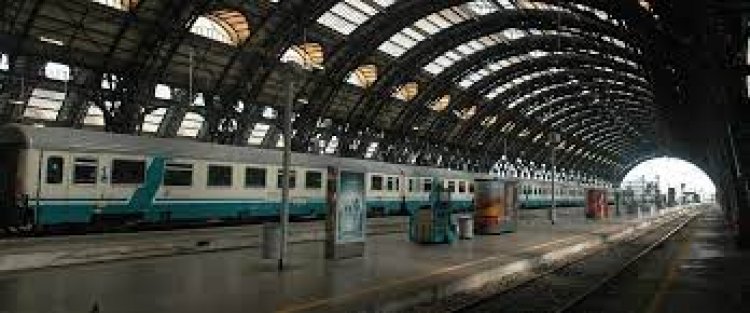
Commentary
By Chitresh Shrivastva
Evolution and Transformation of Indian Railways
In the post-colonial period, railways have emerged as the key instrument in driving a country's economy. In the recent past, it has also emerged as a critical diplomatic instrument in strengthening foreign ties of a country through cross-border train services and technology transfer for modernizing the third world railway networks. India is no exception to the constantly changing nature of the international railway community and has been engaging with other countries globally, like the International Railway Union, since 1957. India's engagement with the global railway community has a long-drawn history—dating back to the early independence period—when India was working towards self-reliance, after a painful partition, by engaging with Switzerland for the establishment of its first indigenous rolling stock manufacturing unit, Integral Coach Factory and with Diesel Locomotive Works (now called Banaras Locomotive Works) in collaboration with the now-defunct American Locomotive Company (ALCO) effectively paving the way for faster, long-haul train operations and induction of high-end electric locomotives for high-speed train operations.
India's motivation for higher speeds gained momentum in 1969 after Japan's successful inauguration of its Shinkansen Bullet Train in 1964—setting the benchmark for other countries. The beginning of the high-speed railway starting from Japan acted as a catalyst for India to reimagine its railway network and gamble for a high-speed railway with the proposal for Rajdhani Express—the first train connecting New Delhi and Kolkata—taking shape around this time and becoming operational in 1969. The idea of a high-speed train in a developing economy like India had its share of challenges as its ambitious high-speed plan was resisted from all quarters on the socio-economic and technical grounds. One of the grounds for criticizing the project came from concerns that the start of Rajdhani would mean contradicting the socialist approach to the economy. India being an emerging economy of industries, would require greater emphasis on freight transportation rather than elite passenger trains like the Rajdhani. On the technical front, apprehensions emerged about the massive investments in the overhaul of infrastructure and the signalling system required. Amidst the concerns and criticisms, India achieved an unimaginable feat with the start of the first Rajdhani starting a new chapter in the modernization of railways.
Despite a marginal increase in the operating speed of train of 120 kmph against the globally accepted speed of 160 kmph, it is worth acknowledging India's great gamble for high-speed train though lagging immensely compared to other nations of the time.
Railways Post-Globalisation: Crisis, Reform and Engagement
The opening up of the global economy to economic transactions and interactions between nations promoted a more competitive environment in diverse economic sectors, including the railways. The operational crisis of 1980 marked the first catastrophic event when the need to reimagine and restructure the railways on the technical front was deeply felt.
In the post-globalization period, the start of the new millennium brought back high-speed rail to the foray. The post-globalization Indian economy was much more stable and balanced on the modernization front, with the dedicated high-speed and freight corridors gaining prominence over the years. But the stiff bureaucracy devoid of long-term vision made it a near-impossible mission; India's push for railway modernization materialized post-2014 with a stronger push from the political corridors realizing the fast-pacing competition that the railways faced from the roadways and the aviation sector by prioritizing projects such as high-speed rail corridors and dedicated freight corridors. With an aggressive push for Foreign Direct Investment, India has been able to seek monetary assistance as well as technical expertise and facilitation from developed nations in expanding its research and development through institutions like the Research, Design and Standard Organisation (RDSO) and upgrading its locomotive and rolling stock—helping the railways develop its long-term blue map for operational efficiency and maximization of operational efficiency.
Players in the International Railway Community
Though conservative approaches may regard the start of globalization as the pathbreaker for aggressive competition—the roots of the global competitive ecosystem can be traced to railways post-independence. Countries worldwide shifted their attention towards modernizing railway networks, some of which left a mark in the global railway community, especially with the intensification of Sino-Japanese competition in the railway arena. With the railways emerging as a diplomatic instrument for trade-off and cultural exchange, third world countries such as India seized the opportunity to reinvent their diplomatic approach in the international arena. The growing attraction for high-speed railways amongst the third world countries encouraged the European countries to put their bet on South Asian countries like India as an essential venue of investment in railway technology. India, in turn, has been actively engaging with the European and American partners adopting technical and financial approaches to catalyze its railway modernization efforts.
Post-2014, the railway modernization programme has seen an active engagement from nations like France, Germany and Southeast Asian nations such as Japan, Korea in technology transfer for India's ambitious high-speed rail corridor. The dedicated freight corridor has seen the active involvement of America and Japan with loans extended by the World Bank and the Japanese International Cooperation Agency with the global objective of mitigating climate change and has attracted the attention of organizations like the Economic and Social Commission for the Asia Pacific (ESCAP) and active engagement of the International Transport Forum of which India is a member. France, Germany and Southeast Asian nations such as Japan, Korea have played a significant role in technology transfer for India's ambitious high-speed rail corridor, while dedicated freight corridor has seen the active involvement of America and Japan with loans extended by the World Bank and the Japanese
India is amongst the countries in the Southern hemisphere, which is fast emerging as a firm representative of the third world railway community, providing fodder for the developed countries to invest in the railway systems, which would help establish links with other third-world countries other transport sectors as well. France and the United States of America are significant players in the aviation market, with narrow and wide-body aircraft through their respective companies – Airbus and Boeing—being the dominant players in aircraft supply globally for commercial aviation operations.
Regional Alliances and Global Railway Expansion
From the perspective of global railway expansion, regional alliances need introspection from an economic point. India has been an active member of regional alliances like the Association of Southeast Asian Nations Regional Forum with the core objectives of promoting economic growth, social progress and cultural development by promoting regional peace and stability.
Financial resources have severely strained member countries of ASEAN such as Myanmar due to underinvestment in the railway sector. The modernization of Myanmar's railway system has been actively pursued by China, which has extended loans to Myanmar as part of its Belt and Road Initiative. Despite China's initial interest in India's railway modernization programme, the Indian hyper-nationalism in a global economic ecosystem has deprived it of the opportunity to seek expertise from China in building its railways across terrains, helping it achieve the objective of connectivity. India's Konkan Railway project is the only example of having connected the impenetrable West Coast.
Domestic institutions such as the Rail India Technical Services (RITES) conducted a study in 2005 exploring the possibility of an Indo-Myanmar rail link from Jiribum to Moreh and Tamu to Kalay line being constructed by Indian Railways to provide a link to Imphal. The anticipated outcome of the operationalization of the line would be a reduction in journey time between Yangon and New Delhi by 60 per cent. The project has failed to progress post the conduction of the feasibility study. The other important link is the Trans-Asian Railway Network. The Trans-Asian Railway Network is a strategic project initiated by the UNESCAP in 1960 to facilitate the linking of Singapore with Istanbul.
The scheme planned to connect the landlocked countries, with the main ports in neighbouring territories, by extending branch lines into Afghanistan, The Lao People's Democratic Republic, and Nepal. One of the challenges though faced in the connectivity is the distribution of railway networks across gauges amongst the various countries, with the majority of Southeast nations following the Narrow Gauge and the South Asian nations such as India, Pakistan, and Bangladesh following the broad gauge, metre gauge, and narrow-gauge network. India has though been actively engaging in the execution of the unique project proposed in 1992 to help accelerate some important projects facilitating cross-border connectivity to areas such as Nepal while also planning cross-border connectivity to countries like Iran and engaging with countries like Sri Lanka and Bangladesh through the export of locomotives and rolling stock apart from engaging in train services with Bangladesh. Therefore, the idea of global railway expansion is beyond just constructing railway lines and countries' participation in the global railway modernization objective. The import and export of railway assets is an addition to strengthening post-globalization economic transactions between countries through railway diplomacy.
Challenges to Creating a New Frontier
The international arena is brutal, fluctuating between countries, determined by their changing national interests and aspirations. Railway diplomacy is no exception. India is an emerging country in the global railway community. The growing popularity of globally strategic projects is a part of its larger objectives because countries have been actively pursuing the development of railway infrastructure compared to the aviation sector. The influential factors of railway diplomacy are the geopolitical and economic interests that determine the kingmaker in the growing field of railway diplomacy. India's challenge in emerging as a dominant player in the third frontier of the global railway community lies in its administrative setup and unstable policy measures denting the confidence of the global railway community.
The push for complete electrification and subsequent proposal to phase out the diesel fleet by the government in 2017 attracting the wrath of General Electrics over possible losses— compelling the government to roll back its decision of cancelling the order for 1000 diesel locomotives ordered from the General Electrics as part of the fleet for the Dedicated Freight Corridor. Further, social and economic constraints in the case of developing economies resulting in the inflation of project costs due to stalling by social movements against the project or unforeseen circumstances and excessive legislative intervention on the development front create an unfavourable environment and prevent the formation of a solid third frontier with no alternatives to other members who can represent the third world in the railway community.
India's hyper-nationalism and isolation of China through systematic exclusion is undoubtedly an impediment to creating a third frontier. Countries with security concerns with China have still engaged in economic engagement with China, realizing Beijing as an indispensable partner in their domestic economic development. India should therefore be more realistic when asserting its presence in a modernization scenario dominated by China and Japan in the present railway modernization in third world countries.
Chitresh Shrivastva obtained his M.Phil. in Public Policy from JAIN (Deemed to be University), Bengaluru, India. He is associated with CHRIST (Deemed to be University), Delhi NCR, India, as a visiting faculty and currently mentors the railway policy team at Youth Policy Review. His broad area of research includes Global and Domestic Railway Policies.
Disclaimer: This paper is the author’s individual scholastic contribution and does not necessarily reflect the organisation’s viewpoint.

